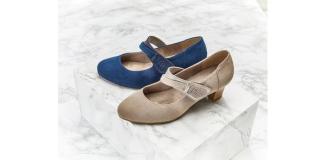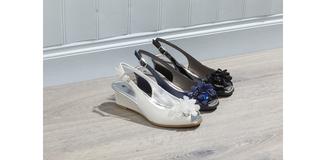
Tips on How to Make High Heels More Comfortable
28 May 2024
Here at Pavers, we believe that the perfect pair of shoes comes down to finding the right combination of comfort, fit and style. And this is as true for high heels as it is for any other style.
We also know that high heels can make your feet sore, and the soreness can be a big factor in people not deciding to wear them. Before you swear them off for good, take a look at our guide for making heels more comfortable: 7 actionable tips you can use to achieve happy high heeled feet.
Here’s what we’ll cover:
- Pains you may experience from wearing high heels.
- 7 methods you can use to make your heels more comfortable.
- The benefits of getting heels right.
You can also take a look at our range of comfortable high heels, or explore our premium comfort features over at The Comfort Hub.
Pains You May Experience from Wearing High Heels
They’re frequently fashionable and can be surprisingly practical if you choose the right style. But it’s undeniable that wearing high heels can lead to discomfort and pain. If you’re encountering any of the problems below when wearing shoes with a high heel, this guide is for you.
The biomechanics of wearing high heels means that your centre of gravity is shifted forward. This impacts posture and spinal alignment and can either strengthen or strain muscles in your back and legs depending on your physique, your fitness, the shape of the heel, how long you wear them for, and various other factors.
Here are some pains to look out for when wearing high heels that can indicate something isn’t right:
1. Foot pain: heels place pressure on your feet, especially on the ball of your foot, which can lead to pain over time. The friction and stress on the skin can also lead to blistering over time, amplifying the discomfort.
2. Ankle strain: because they’re often less stable than regular shoes, high heels decrease the natural ability of your foot to balance. This puts pressure on your ankle and its ligaments and can even increase the risk of strains and sprains.
3. Back pain: some people find this really surprising to learn, but poorly fitting or uncomfortable shoes can lead to pain in other areas of your body, too. High heels change the natural alignment of your body, putting strain on your lower back and leading to further discomfort.
Whether you’re just starting to notice one or more of these pains, or you’ve been hurting for a while, fear not: there are things you can do to make your heels more comfortable.
7 Methods You Can Use to Make Your High Heels More Comfortable
We recommend working through the list and trying whichever method(s) catch your interest.
1. Choose the Right Size
Sometimes a shoe can be the right size but still cause pain. We always recommend breaking in a new pair of shoes by wearing them around the house for a while before taking them outside. This softens the material and increases the flexibility, allowing them to better adapt to your foot shape. It also lets you identify problem areas and, if necessary, to take the shoe back for a refund if it’s obviously the wrong size.
2. Break Your High Heels In
Sometimes a shoe can be the right size but still cause pain. We always recommend breaking in a new pair of shoes by wearing them around the house for a while before taking them outside. This softens the material and increases the flexibility, allowing them to better adapt to your foot shape. It also lets you identify problem areas and, if necessary, to take the shoe back for a refund if it’s obviously the wrong size.
3. Choose Thicker Heels
Often a contributing factor to foot pain when wearing heels is the distribution of pressure. With a thin heel the weight distribution is more towards the front of your shoe, leading to more discomfort and pain in the ball of your foot. Choosing a thicker heel balances out the distribution and eases the pressure, reducing pain.
4. Choose Lower Heels
Similarly, choosing a lower heel or mid heel shoes makes it easier to balance, reducing the pain associated with your feet trying harder to compensate for being unsteady. Limiting heel height reduces pressure on the ball of your foot and reduces the arching of your back, meaning less strain on your feet, ankles, legs and spine.

5. Choose a Less Extreme Slope
While points 4 and 5 seem similar, but if you’re keen to achieve a comfortable heel without sacrificing the height aesthetic there is an important distinction. Choosing a lower heel reduces the overall height of the shoe, but it’s still possible to reduce the intensity of the angle between front and back without dropping the overall height.
To achieve this, choose shoes or sandals with a wedge heel or a platform under the sole to create a gentler slope, while retaining a higher overall distance from the ground.

6. Use Specialised Insoles or Inserts
Insoles and inserts are used to provide padding and support for your feet, further reducing pressure and discomfort while wearing them. This is a great option if you’re experiencing new discomfort in a pair of shoes that have previously been comfortable, and that you’re unable to refund or exchange for a better fitting pair.

7. Alternate Your Footwear
Limiting the amount of time your feet spend in heels will lower the likelihood of discomfort and pain, as often the effect is cumulative. By wearing heels less often, or by alternating them with comfortable flats or trainers throughout the day - perhaps while you’re travelling to and from wherever you’re planning to wear them - will give your feet a chance to recover between stints.
If you’re looking for another pair of shoes to wear while you’re out and about, our range of women’s shoes features trainers, sandals, clogs, and many more. Each item in our range is selected for comfort.
The Benefits of Getting Heels Right: What Makes Heels Comfortable.
If you’re feeling sore from wearing heels, you’re not alone! But now let’s switch things up and take a quick look at some of the benefits of heels, and why we believe they can have a place in any shoe collection:
- Boosted confidence: for better or worse, high heels have certain associations including professionalism and sophistication. For many women wearing them is a way to tap into this image and feel more confident.
- Enhanced posture: high heels can encourage you to stand more upright, which can lead to improvements in posture.
- Strengthened leg muscles: because of the additional effort required to balance, high heels can help to tone and strengthen your leg muscles over time.
- Stylish: take a look at photos from any formal gathering and you’ll see lots of high heels. This is because they’ve become recognised as great footwear for formal and semi-formal occasions, complementing the dresses and other formal wear such situations invite.
You’ll Be in High Spirits
There’s a reason high heels are popular: they’re stylish, versatile, and they can feel great. If you’ve got a pair causing you discomfort or pain, there are things you can do to fix it. We hope this guide has been useful in diagnosing and solving the problem, giving you the comfort and confidence to wear your heels with pride.
At Pavers we’re firm believers that investing in comfortable shoes from the outset is the best way forward. Our range of comfortable high heels is handpicked to ensure that magic balance of comfort, fit and style. Explore our collection today to discover which pairs truly shine.
